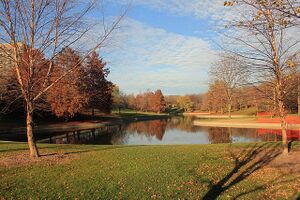
- New Zine Highlights the Solidarity Economy in St. Louis, Nov 30, 2016...[1]
Networks and sustainability initiatives
Ecovillages
Biodiversity
Missouri Botanical Garden
The Missouri Botanical Garden is a botanical garden located at 4344 Shaw Boulevard in St. Louis, Missouri. It is also known informally as Shaw's Garden for founder and philanthropist Henry Shaw.
Missouri Department of Conservation
The Missouri Department of Conservation (MDC) and the Missouri Conservation Commission were created by Article IV Sections 40-42 of the Missouri Constitution, which were adopted by the voters of the state in 1936 as Amendment 4 to the constitution. The Commission is vested with control, management, restoration, conservation, and regulation of fish, forest, and wildlife resources of the state.The Department of Conservation owns and oversees hatcheries, sanctuaries, refuges, and reservations, and enforces the state wildlife code. The Commission consists of four individuals appointed by the Governor of Missouri to serve unpaid 6-year terms. No more than two of the individuals may be from the same political party.
Wildlife of Missouri
Missouri is home to a diversity of flora, fauna and funga. There is a large amount of fresh water present due to the Mississippi River, Missouri River, and Lake of the Ozarks, with numerous smaller rivers, streams, and lakes. North of the Missouri River, the state is primarily rolling hills of the Great Plains, whereas south of the Missouri River, the state is dominated by the oak-hickory Central U.S. hardwood forest.
Trees, woodland and forest
Recreational and commercial uses of public forests, including grazing, logging, and mining, increased after World War II. Fishermen, hikers, campers, and others started lobbying to protect forest areas with a "wilderness character". During the 1930s and 1940s Aldo Leopold, Arthur Carhart and Bob Marshall developed a "wilderness" policy for the Forest Service. Their efforts bore fruit with the Wilderness Act of 1964, which designated wilderness areas "where the earth and its community of life are untrammeled by men, where man himself is a visitor and does not remain." This included second growth public forests like the Mark Twain National Forest.
Mark Twain National Forest (MTNF) is a U.S. National Forest located in the southern half of Missouri, composed of nine disconnected parcels. MTNF was established on September 11, 1939. It is named for author Mark Twain, a Missouri native. The MTNF covers 3,068,800 acres (12,419 km2) of which 1,506,100 acres (6,095 km2) is public owned, 78,000 acres (320 km2) of which are Wilderness, and National Scenic River area. MTNF spans 29 counties and represents 11% of all forested land in Missouri.
Community currencies activism
Community energy
Solar power in Missouri has been a growing industry since the early 2010s. Solar power is capable of generating 42.7% of the electricity used in Missouri from rooftop solar panels totaling 28,300 MW.
Net metering is available only during a billing period. Excess generation is credited at avoided cost rate, and lost if any remains after a year, giving the state a B rating.
IKEA installed a 1.28-MW solar array on its St. Louis store which was the largest rooftop installation in the state. It was completed in July 2015.
Missouri's largest solar farm is located in Christian County, just outside of Nixa on a plot owned by Gardener Capital. The farm generates 9% of the power needs of Nixa, Missouri transmission grid.
Cycling activism
Wikipedia: Bike paths in Missouri (category)
Education for sustainability
The EarthWays Center is a group at the Missouri Botanical Garden that provides resources on and educates the public about green practices, renewable energy, energy efficiency, and other sustainability matters. W
Food activism
Sustainable transport activism
Wikipedia: Hiking trails in Missouri (category)
Towards sustainable economies
St. Louis
Solidarity Economy St. Louis is currently working to incubate African-American cooperative businesses, co-host a local conference around the theme of "Health, Wealth, and Disrupting Capitalism," develop a time bank youth court program, engage in community organizing efforts to create a neighborhood food hub in the food desert of North St. Louis, and promote community development of vacant land.
"Being part of the Mutual Aid Network allows us to connect to and co-create a global movement of people who are working to build just and sustainable economies," says Julia Ho, founder of Solidarity Economy St. Louis. "The only way for us to truly achieve mutual aid in our own communities is by extending mutual aid to others."[2]
Citizens data initiative
Energy & Environmental Data for Missouri
News and comment
2015
Science Center Announces Permanent "Farm to Food" Exhibit, November 24[3]
St. Louis Rooftop Farm Aims For Community Revitalization, Bridging Divides, July 1[4]
Dancing Rabbit Ecovillage: Living Abundantly on 10%, March 10[5]
2014
Kansas City passes anti-harassment law to protect cyclists and pedestrians, October 15[6]
About Missouri
Missouri ( miz-OOR-ee) is a landlocked state in the Midwestern region of the United States. Ranking 21st in land area, it borders Iowa to the north, Illinois, Kentucky and Tennessee to the east, Arkansas to the south and Oklahoma, Kansas, and Nebraska to the west. In the south are the Ozarks, a forested highland, providing timber, minerals, and recreation. The Missouri River, after which the state is named, flows through the center and into the Mississippi River, which makes up the eastern border. With over six million residents, it is the 18th-most populous state of the country. The largest urban areas are St. Louis, Kansas City, Springfield, and Columbia; the capital is Jefferson City.
References
